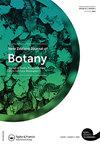Two new species and a new host record of Pleosporales (Dothideomycetes) from palm ( Arecaceae ) in Guangdong Province, China
IF 1.4
4区 生物学
Q4 PLANT SCIENCES
引用次数: 0
Abstract
ABSTRACTPleosporales is the largest order of Ascomycota which is distributed worldwide. Among the wide range of hosts, Pleosporales species are frequently isolated from palms. During the surveys of palm fungi from 2020 to 2021, rotting tissues of Licuala peltata var. sumawongii, Phoenix roebelenii and Trachycarpus fortunei were collected in Guangzhou, Guangdong Province, China. Fungal isolates were identified based on morphological characteristics and multi-gene phylogenetic analyses. In the present study, we introduce two new species viz. Byssosphaeria guangdongense and Paraconiothyrium guangdongensis. In addition, we introduce a new host record for Trachycarpus fortunei. Photo plates, detailed descriptions, and in-depth phylogenetic analysis results are provided for all identified taxa. Our findings expand the understanding of the fungi that are associated with palm hosts. Moreover, our data will contribute to the knowledge of the biodiversity of South China.KEYWORDS: ByssosphaeriaMagnibotryascomaParaconiothyriumphylogenysaprobic fungi2 new species AcknowledgementsWe would like to thank Dr Shaun Pennycook, Nomenclature Editor of Mycotaxon, for his guidance on the species names. Ishara S Manawasinghe would like to thank the Research Project of the Innovative Institute for Plant Health (KA21031H101) and the project of the Zhongkai University of Agriculture and Engineering, Guangzhou, China (KA210319288). Dhanushka Wanasinghe would like to thank CAS President’s International Fellowship Initiative (grant number 2021FYB0005), the National Science Foundation of China (NSFC) under the project code 32150410362 and the Postdoctoral Fund from Human Resources and Social Security Bureau of Yunnan Province. Biao Xu would like to thank the Innovative team program of the Department of Education of Guangdong Province (2022KCXTD015 and 2022ZDJS020). Zhangyong Dong would like to thank the Key Realm R & D Program of Guangdong Province (2018B020205003).Disclosure statementNo potential conflict of interest was reported by the author(s).Additional informationFundingThis research was funded by the High-level Talents at Zhongkai University of Agriculture and Engineering, grant no: J2201080102.广东棕榈(槟榔科)多孢子菌属二新种及寄主新记录
摘要多孢子亚纲是子囊菌纲中最大的一目,分布在世界各地。在广泛的寄主中,多孢子菌经常从棕榈树中分离出来。在2020 - 2021年的棕榈真菌调查中,在广东广州采集了棕榈叶荔枝(Licuala peltata var. sumawongii)、凤凰花(Phoenix roebelenii)和福星树(Trachycarpus fortunei)的腐烂组织。根据形态特征和多基因系统发育分析对分离的真菌进行鉴定。在本研究中,我们引进了两个新种,即广东绿球藻(Byssosphaeria guangdongense)和广东副甲状腺(Paraconiothyrium guangdongensis)。此外,我们还介绍了一种新的寄主记录。照片板,详细的描述,和深入的系统发育分析结果提供了所有已识别的分类群。我们的发现扩大了对与棕榈宿主相关的真菌的理解。此外,我们的数据将有助于了解中国南方的生物多样性。【关键词】byssosphaeriamagnibotryascomaparaconiothyriumphylogenysapproic fungi2新种】致谢我们要感谢Mycotaxon的命名编辑Shaun Pennycook博士对物种命名的指导。Ishara S Manawasinghe感谢植物健康创新研究所研究项目(KA21031H101)和中国广州中南农业工程学院项目(KA210319288)。Dhanushka Wanasinghe感谢中国科学院院长国际奖学金计划(资助号2021FYB0005)、中国国家科学基金(项目代码32150410362)和云南省人力资源和社会保障局博士后基金的资助。徐彪感谢广东省教育厅创新团队项目(2022KCXTD015和2022ZDJS020)。董张勇感谢广东省重点领域研发计划(2018B020205003)。披露声明作者未报告潜在的利益冲突。本研究由仲恺农业工程学院高层次人才资助,批准号:J2201080102。
本文章由计算机程序翻译,如有差异,请以英文原文为准。
求助全文
约1分钟内获得全文
求助全文
来源期刊

New Zealand Journal of Botany
生物-植物科学
CiteScore
2.20
自引率
22.20%
发文量
27
审稿时长
>12 weeks
期刊介绍:
The New Zealand Journal of Botany publishes original research papers, review papers, perspectives, short communications, forum articles, letter and book reviews. We welcome submissions relevant to all aspects of the botany, mycology, and phycology of the South Pacific, Australia, South America, and Southern Africa. The journal’s subject matter encompasses biosystematics and biogeography, ecology, physiology, biochemistry, genetics, reproductive biology, structure and development, taxonomy, ethnobotany, palaeobotany, bryology, lichenology, mycology, plant pathology, and phycology.
 求助内容:
求助内容: 应助结果提醒方式:
应助结果提醒方式:


